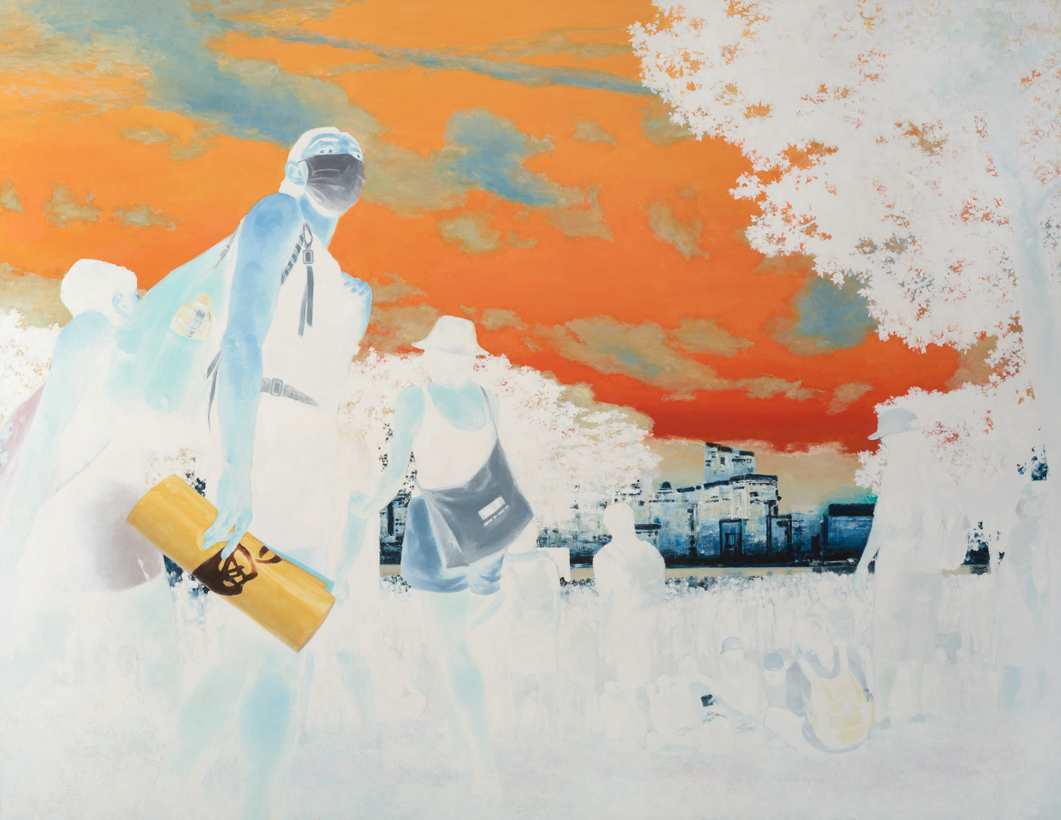The Myth of Aura: Decayed or Reborn?
Arwen Chen
→EFS 2028
 Yeung Tong Lung 楊東龍 , 3-Fold. Photo, 2024, oil on canvas. Courtesy of the RISD Museum, Providence, RI
Yeung Tong Lung 楊東龍 , 3-Fold. Photo, 2024, oil on canvas. Courtesy of the RISD Museum, Providence, RIWalter Benjamin proposes in his renowned essay, “The Work of Art in the Age of Mechanical Reproduction,” that traditional art forms—such as painting and sculpture—possess a unique, irreplicable quality rooted in their authenticity, originality, and singular existence in time and space, which he defines as “Aura”.1 He argues that with the advent of digital media, like photography and film, Aura diminishes, as mechanically reproduced copies lack the uniqueness, historical presence, and context of the original work.2 While Benjamin mourns its decay, other scholars, such as Warwick Mules, reinterpret this decay as a productive loss, highlighting the affirmative potential of mechanical reproduction, particularly in the democratization of art and its capacity for political and social engagement.3
Both Benjamin and Mules trace Aura back to an “original artwork,” examining its absence in reproductions under the shared premise that mechanical reproduction disrupts an already complete presence. However, this shared assumption about the “original” overlooks a crucial point: even traditional handmade artworks that predate mechanical reproduction are themselves representations of reality—not reality itself. As mediated translations of the world shaped by the artist’s subjective interpretation, these works inherently fail to capture the full essence or idea behind their creation. In this sense, absolute authenticity is not a given quality that gives rise to Aura as Benjamin suggested, but merely an ideological construct—one that was already fractured long before the age of mechanical reproduction. Rather than seeing Aura as something that fades through reproduction, an alternative view is provided: Aura emerges precisely from this inevitable loss, from the unbridgeable distance between authenticity and expression. How, then, can we claim that it necessarily diminishes with further mechanical reproduction?
Manual Translation and Mechanical Reproduction in 3-Fold. Photo
Hong Kong artist Yeung Tong Lung’s oil painting 3-Fold. Photo exemplifies how Aura is specifically generated through layers of art creation: from the world, the primal origin, to the so-called original painting and finally to the viewer’s camera. This painting and its unusual exhibited mode embody both manual translation and mechanical reproduction processes, which shows that Aura emerges from the ineffability of authenticity, regardless of the medium. This leads to a series of important questions: does the uniqueness implied by Aura necessarily equate to authenticity? Does authenticity truly reside within any particular artwork, or is it a construct that manifests through the layers of translation, reproduction, and reinterpretation?
3-Fold. Photo is an oil painting executed on a 185 x 240 x 3.7 cm canvas that features a striking contrast between colors and forms. The most visually arresting element is the inverted color scheme that mimics the look of a negative film. Figures and foliage in the foreground are rendered in pale blues, whites, and grays, with a nearly translucent texture, giving them an otherworld, ghostly appearance. The bright orange sky dominates the upper half of the composition, contrasting sharply against the muted tones of the figures and cityscape. The central figure, the focal point, is positioned slightly off-center in the middle left of the canvas, occupying nearly one-third. This figure, wearing a black mask, evokes themes of anonymity and isolation.
What makes this work even more intriguing is its interaction with modern technology. When the work is viewed through a phone camera’s inverse mode, the image reverts to more natural colors: the orange sky reverts to its original blue, and the ghost-like figures gain their concrete bodies. By making the phone camera an indispensable part of the artwork, Yeung questions whether things we see through our naked eye are always authentic and how modern technology affects our perception of reality.
3-Fold. Photo involves the manual translation of reality onto the canvas painted by hand and the mechanical reproduction through the phone camera. As viewers increasingly perceive the world through screens rather than direct sight, Yeung’s work unfolds these two processes in an exaggerated yet straightforward way: even what is seen with the naked eye might have been impacted, as seen in the negative-film quality mimicked by the painting, and even distorted, such as the normal color scheme captured through a phone camera in inverse mode, by digital media. Technology is changing how we see the world, making it harder to discern and define reality.
Yeung is aware of the immense impact of technology on viewers’ interpretation of artworks and recognizes that the viewers’ use of phones and cameras can further alter their interpretation of the piece. The same painting can appear differently depending on the angle or lighting in a photograph, which means artists possess limited control over how their work is understood and interpreted. However, Yeung is very optimistic about this limitation: “a painting is not only about whether the audience can or can not understand anything about it. Instead, it is about the intellectual space it creates for you to think.”4 As Roland Barthes famously claimed, once an artwork is openly displayed, disconnection occurs and artists enter their own “death:” artists could no longer dictate a determined, fixed message to the audience.5
Beyond the Artist-Viewer Relationship: The World as Primal Origin
Thus far, our discussion has primarily centered on mechanical reproduction and the relationship between the artist and the viewer. According to Benjamin, as Yeung’s painting undergoes endless duplication through cameras, these reproductions lose the uniqueness and authenticity of the original—a consequence of the decay of aura. While uniqueness is undeniably diminished in the process of reproduction, does authenticity and originality vanish as well? Does the “original work” truly exist or is it merely a human-constructed concept?
To address these questions, we must look beyond the artist-artwork-viewer relationship and consider the primal origin that precedes the artist within this chain—something beyond human reach: the world itself. Whether traditional paintings or photographs, figurative or abstract, art remains a representation of the world. Thus, the so-called origin of an artwork is not a primary source, but rather something already processed, interpreted, and re-created by the artist—a secondary product. In this sense, the aura is not original. The moment art is created, it becomes a secondary representation—expression is an act of selection imbued with subjectivity. Benjamin’s description of Aura as a psychological distance between the audiences and the original artwork should therefore be slightly revised: it is the unbridgeable distance between the essence and representations.
Aura: the Melancholic Charisma of Art
In light of this redefinition, Aura should not be understood as an innate, static quality residing within the artwork itself, but rather as something dynamic—something that continually emerges through processes of mediation and translation. As the gap between representation and essence widens through successive phases of manual translation and mechanical reproduction, the initial impulse and intent behind the artwork gradually fade. Art thus transforms from a finished object into an ever-evolving continuum.
Yeung’s 3-Fold. Photo undergoes color inversion twice—first from the natural scene to canvas, then from canvas to phone camera—demonstrating how distance from the primal origin expands throughout different stages of creation. It is through this insurmountable gap that we are invited to reflect freely on our relationship to art, technology, and nature, leading to the deconstruction of predetermined authorship and allowing the painting to transform from a static artifact to a site of continual becoming.
This shift in how we engage with artworks reframes the idea of Aura itself. Rather than decaying, Aura—that which renders an artwork psychologically distant and spiritually resonant—is continuously generated through conception, practice, exhibition, and even mechanical duplication. Through these very acts, the distance is not only preserved but made perceptible and affective. While Robert Frost once claimed that poetry is what gets lost in translation; it could be better to say that poetry—Aura—is precisely what is born in translation.

Arwen Chen is lost in translation.
Notes
- Benjamin, Walter. “The Work of Art in the Age of Mechanical Reproduction” New York, 1935.
- Benjamin, “The Work of Art in the Age of Mechanical Reproduction,” 4.
- Mules, Warwick. “Aura as productive loss.” In Transform-ations, 15. 2007.
- M+ Team. “Yeung Tong Lung: A Space Beyond Words.” M+ Magazine, January 13, 2020. https://www.mplus.org.hk/en/magazine/yeung-tong-lung-a-space-beyond-words/.
- Barthes, Roland. “The death of the author.” In Readings in the Theory of Religion, 141–145. Routledge, 2016.